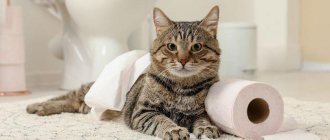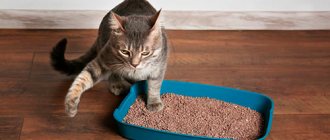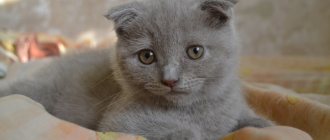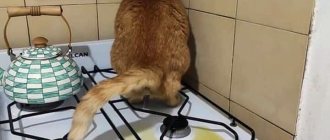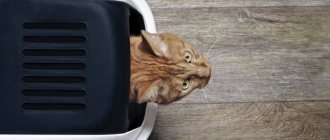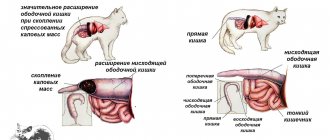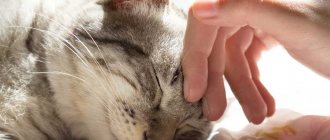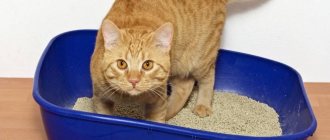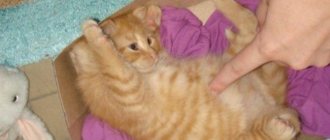How often do cats go to the toilet?
When a cat goes to the toilet a little at a time, this in most cases indicates pathology.
The norm for visiting the litter box is determined by the age of the pet. Up to 3 months, a cat pees once a day. This is a norm associated with the characteristics of metabolic processes.
From 3 months, visiting the tray is required 2 times a day. Starting from 4 months, young and adult cats urinate 3 times, and males urinate 4 times a day.
Castrated and sterilized cats have a greater need to visit the litter box.
It is normal for them to urinate up to 5 times a day. When feeding animals dry food, the volume of urine decreases. In hot weather, when pets drink more water due to overheating, visiting the litter box up to 7 times a day can be the norm.
Problems with the tray itself
Why does a cat shit anywhere if it is completely healthy? The reason is quite banal. For example, she doesn’t like the tray itself or the unusual filler. Many companies produce similar products. And not all of them care about the quality of the raw materials used. The new tray is made of cheap, low-quality plastic and, as a result, the cat craps everywhere. What to do in this case?
Well, first of all, change the tray. It is better to purchase a more expensive model, but from a trusted manufacturer. Secondly, you should carefully consider the choice of filler. You may have to go through several options until you find one that suits the animal.
Can't understand why a cat shits everywhere? Look in the tray. When was the last time you cleaned there? Cats are clean animals. They won't write where it's dirty. Some pets force owners to clean the litter box after each visit.
Or maybe, on the contrary, you are too zealous about cleaning the cat litter and abuse detergents? Many household chemical smells simply repel animals. If you recently changed the disinfectant, this may also be the reason why the cat began to shit everywhere.
The size of the cat litter box can also be a source of problems. Perhaps your pet has simply grown up and felt cramped in the old tray. It will be enough to replace the container with a more spacious one, and everything will work out.
The placement of the tray itself may also be a problem. A cat will never do its business in front of a large crowd of people or, for example, in a draft. It is best to place the tray in a secluded place, away from the front door or passage. You can put it in the toilet or bathroom, but you must make sure that the door there is always open. The cat will not go to the toilet where it eats. Therefore, keep your cat's litter box away from food and water bowls.
For the shyest animals, a closed toilet, in the form of a house, will suit you.
Reasons why pollakiuria may occur
The reasons why a cat begins to visit the toilet frequently, and urine output is insignificant, can be pathological and physiological. In the first case, the animal requires treatment, and in the second, the phenomenon is considered normal and should not cause concern.
If the owner cannot independently understand whether the animal is sick or not, consultation with a veterinarian is required, and urgently.
Many diseases of the bladder, kidneys, and metabolic diseases can be treated quite effectively, but if detected at an early stage. Some pathologies are chronic and the animal requires regular maintenance therapy.
What is cystitis and why does it appear?
The main reason for frequent visits to the toilet, when there is little urine left in the tray, and sometimes it is mixed with blood, is cystitis. This inflammatory disease of the bladder does not occur without provoking factors.
Be sure to read:
A cat pees with blood: causes, first aid, how to treat it at home, consequences
Cystitis occurs as a primary pathology or complication. Depending on this, the necessary therapy is determined.
The development of cystitis in cats can be provoked by:
- disturbance of metabolic processes in the body (most often observed in old animals);
- suffered a severe infection;
- the presence of stones and sand in the kidneys, ureters or bladder;
- disturbance in mineral balance;
- improper nutrition, in which the cat does not receive enough proteins and fluids;
- infection of the genitourinary system;
- pregnancy and childbirth (cystitis can occur as a complication);
- cold.
Abdominal injuries can trigger the development of cystitis in a cat. This phenomenon is more typical of animals that have free access to the street, but can also be observed in apartment pets during unsuccessful jumps from a height.
The main reason for frequent visits to the toilet is when there is little urine left in the tray, and sometimes it is mixed with blood
With cystitis, a cat not only experiences frequent urination, but also meows when going to the toilet, as the process is accompanied by pain. Due to pain, the pet's behavior when trying to touch its stomach becomes aggressive.
Urolithiasis disease
Urolithiasis occurs in most older pets and some young ones. The risk of pathology in neutered cats that receive improper nutrition increases slightly. In this case, the owners themselves are to blame for the fact that the animal begins to get sick.
For neutered pets, you should use only special ready-made food or coordinate their natural diet with a veterinarian.
Stones not only injure the mucous membrane, causing irritation and inflammation, but also lead to blockage of the ureter, which impairs the flow of urine. If urine stagnation occurs and the cat does not receive emergency treatment, it dies within a few days.
The fact that an animal has urolithiasis can be guessed by its too frequent visits to the tray, during which urine is excreted in small quantities mixed with blood.
At the same time, the general condition of the animal worsens. A complete lack of urination is an emergency condition when you cannot postpone a visit to the veterinarian even for a day.
Urolithiasis develops slowly. First, sand deposition begins in the kidneys. It does not interfere with the flow of urine and rarely causes any symptoms. Remaining in the kidneys, sand becomes compacted over time, and stones begin to form.
Be sure to read:
Diarrhea in a kitten: what to do, first aid, causes, treatment, medications and folk remedies
Fractions increase gradually. Small in size, they pass through the ureters and are partially removed in the urine. If treatment is not started at this stage, the stones will enlarge and cause health problems for the pet.
If your cat goes to the toilet frequently due to diabetes
Cats with diabetes also experience increased urination . At the same time, the animal's thirst increases. The cat begins to drink excessive amounts of water and, as a result, the need to visit the litter box increases.
The kidneys suffer from high levels of glucose in the blood and cannot cope with the load. As a result, despite the increased urge, the volume of urine released decreases. Treatment of the animal requires comprehensive treatment.
Behavior correction
If, after cleaning the “puddle,” the cloth lies in the baby’s tray, then he will remember by the smell where to defecate.
If you have problems visiting the kitten's litter box, it is important for the owner to be patient and try to accustom the animal to the toilet. To do this, you need to monitor the baby, and wipe the place where he wrote with paper or cloth, and treat the surface with a chlorine-containing agent. Next, place the wet paper or cloth in the tray and let the kitten sniff. Next time the baby will look for a place to pee by smell, so until he has reliably relieved himself in his toilet, it is not recommended to regularly wash the litter box.
If an adult cat begins to pee wherever she wants, it will be much more difficult to wean her from this bad habit. Places where the animal has made puddles must be immediately cleaned and treated with chlorine-containing products; to be on the safe side, you can additionally use a special behavior correction spray. The next step is to change the tray. It is recommended to buy a comfortable, spacious toilet where the animal will feel comfortable. In addition to the hygiene item itself, it is recommended to choose a high-quality filler.
When cats urinate past the litter box out of spite, it is most likely due to stress. In this case, the correction methods proposed above will not be enough. First you need to eliminate the very cause of stress, and for this the owner will need patience and a lot of time. It is important to observe the cat and try to determine what is bothering and frightening it. In addition to observation, you should communicate and play with your pet, show affection and tenderness.
What to do when a disease is diagnosed?
If the animal is old and after castration, then it is better to show it to the doctor to check for the presence of ailments.
If an old or neutered cat starts peeing anywhere, you need to take your pet to the vet as soon as possible, because such behavior can be a symptom of urolithiasis, cystitis and other internal diseases. After determining the diagnosis, the doctor will prescribe a medical or surgical treatment regimen aimed at eliminating the primary source of urinary incontinence.
Causes not related to illness
Diabetes mellitus in cats also causes increased urination.
Veterinarians also identify causes that are not related to the disease. With them, the cat does not require treatment. They are associated with temporary external influences or the physiological needs of the pet.
The general condition of the cat rarely suffers.
Stressful situation
Stress occurs in cats just as it does in humans. The phenomenon can be triggered by moving, the appearance of another animal or a new person in the house. In addition to frequent visits to the litter box, stress is indicated by a change in the cat’s behavior and an increase or decrease in appetite.
During periods of stress, cats experience a drop in immunity, resulting in a risk of developing cystitis. Thus, stress, which usually goes away on its own, can provoke an inflammatory process that requires treatment.
Because of this, if, due to stress, the cat’s urination becomes not only frequent, but also mixed with blood, a visit to the veterinarian is required.
Extreme thirst and drinking too much water
In the heat, the animal consumes a large amount of water, which leads to increased formation of urine and its frequent excretion. This process is natural and does not require treatment. As soon as the cat stops suffering from the heat and drinking excess water, frequent trips to the toilet will end.
If the air temperature is normal, and the pet suddenly starts drinking a lot of water, this is a sign of the development of pathology. When examined in such a situation, the cat may be diagnosed with diabetes, kidney pathologies, or cancerous tumors in the intestines. The necessary treatment will be determined by your veterinarian.
Be sure to read:
Black feces in a cat: normal or pathological, when is it a dangerous symptom, diagnosis, how to treat
Territory designation
Cats and some cats mark their territory with urine. They splash on different surfaces while standing, raising their tail and shaking it. The urine has a special pungent odor. It is impossible to confuse this action with a regular trip to the toilet.
Re-education of kittens
Everything is easy and relaxed with a kitten - there is no need to retrain him. First you need to watch the cat and wait until he wants to go to the toilet.
Blot the puddle with a cloth or toilet paper and transfer it to the tray. Then wipe up the puddle and treat the area with bleach.
The tray should be in the room where the kitten peed. Pour a little litter into the litter box, put that cloth there, then take the cat to the litter box. He must remember where the tray is located.
IMPORTANT! During the first week, you should not wash your cat’s litter box, as he is guided by the smell. You can wash the tray only if your pet has worms.
Diagnosis of cystitis
When the first signs of the disease appear, you should contact a veterinary clinic. To confirm the diagnosis you will need:
- urine test result. Depending on the severity of the inflammatory process, protein, mucus, leukocytes, red blood cells, epithelium, pus, blood, and salt crystals may be present in the urine. The laboratory must also conduct a bacteriological study (bacterial culture) to isolate pathogenic microflora (cocci, streptococci, Escherichia coli, Pseudomonas aeruginosa, etc.) and determine the reaction to sensitivity to antibiotics
- cystoscopy - examination of the bladder using a special device
- ultrasonography
- clinical and biochemical blood tests, which may indicate kidney problems and other abnormalities
- Possible smear test for genital tract infections
How to stop a cat from pooping anywhere?
First of all, you need to correctly identify the cause of bad behavior and be patient. Cruel methods will not only not bring results, but, on the contrary, can make everything worse. Here is a list of what you should never do when communicating with an animal:
- scream;
- water;
- poke your nose into the puddle you just made;
- forcefully drag him to the tray and place him there;
- hit with your hand, a rag, a newspaper, a slipper or any other objects.
All these actions will only anger the animal, and the pet will begin to take revenge on you with triple force. It will be much more useful to quickly take the cat to the litter box if you see that it is settling into the toilet in the wrong place. Afterwards, it is necessary to reward the animal for correct behavior.
Here are a few tips to follow to prevent “toilet matters” from going beyond the litter box:
- Monitor your cat's diet. She should not feel hungry or thirsty.
- Check your pet for the presence of worms and regularly give appropriate medications for prevention.
- At the slightest suspicion of health problems, take your pet to the veterinarian.
- Place the animal's litter box in a quiet, secluded place and provide him with unobstructed access there.
- Clean the litter box as often as possible, preferably after each visit.
- To wash your cat's potty, use only mild soap-based products that do not have any strong unpleasant odors.
- If you decide to change the brand of filler, do it gradually. Mix the new and old composition little by little. Give your cat time to get used to the new changes.
What to do at home
Self-medication is dangerous to health! Using medications, especially human medications, without consulting a specialist can worsen the situation!
You need to understand that involuntary urine leakage is not mischief or stubbornness at all, it is a disease from which the pet suffers. Follow all the veterinarian's instructions and provide your pet with good care and adequate feeding.
And, of course, surround your four-legged pet with love and care so that he feels safe.
Why does a cat start shitting?
If the cat consistently went to his litter box, and then suddenly his behavior changed, it is useless to scold and punish him. Until the owner finds the cause and eliminates it, the “dirty tricks” will continue, despite the fear of punishment.
If there is a smell of cat urine throughout the apartment, and yellow, foul-smelling splashes are found in the corners, on the furniture, on the door frames, and at the same time the cat regularly visits the litter box - he is not “shitting”, he is marking his territory.
This is completely normal, natural behavior for a cat. Hasn't this happened before? Perhaps your boy has simply matured...And is declaring his new status. And at the same time, it attracts potential brides. He doesn’t know how and where to look for them. And instinct says: “scare away your rivals and attract your friends!” So he tries, poor thing, and leaves marks. But for some reason the owners are unhappy...
An adult cat may also suddenly begin to mark. This is usually associated with some changes in the life of the family that make the cat doubt his position, status and thus try to “put things in order,” and at the same time make sure that everything is still under his control.
An adult cat may begin to mark the territory if the apartment has been renovated, because there are foreign smells everywhere, which means the situation needs to be corrected urgently.
Cats are also confused by changes in family composition - the appearance of a child, the arrival of relatives. The situation becomes especially difficult if, due to a change in marital status, the cat begins to feel a lack of attention to his person. Here not only marks are used, but also outright rudeness - fragrant “piles” on the master’s bed, described favorite shoes, etc.
Such demonstrative behavior is usually accompanied by other manifestations. The cat may become aggressive and refuse to be handled. There are such “smart guys” who are capable of breaking the owner’s favorite vase, knocking over indoor flowers, and not out of mischief and not at all by accident. This is a planned and carefully executed plan of revenge against the traitorous owner, who dared to bring his wife into the house and now spends time with her, ignoring his previously beloved and only cat.
Symptoms
With night incontinence, the pet wakes up “in a puddle”; with urgent incontinence, the pet does not have time to run to the litter box. Reflex voiding is the most noticeable: the animal can urinate anywhere at any time.
The owner needs to analyze the general condition of the animal, for example, lethargy, drowsiness, aggressiveness or irritability. Other behavioral disorders: anxiety, refusal to go to the litter box or, conversely, frequent visits to the toilet, also require attention. Pink urine in a cat, the presence of mucus and impurities in it, is an important “bell” to immediately consult a doctor. Do not try to treat the animal yourself. Only after a complete examination and passing all tests can treatment be prescribed.
Opinions, advice and special remedies
There are also folk remedies that can discourage a cat from peeing in the wrong place. The following substances are excellent for these purposes:
- garlic, onion;
- alcohol, iodine;
- cloves, cinnamon;
- cayenne or regular black pepper;
- lavender;
- thyme;
- lemongrass;
- rue;
- vinegar essence.
Cats have a particular dislike for citrus fruits. In places chosen by cats for their “deeds”, you can lay out the peels of lemons or oranges. According to reviews from animal owners, some people find that spraying a tincture based on wormwood, garlic and onion peel helps. The product is taken into a spray bottle and sprayed in corners, under sofas and behind cabinets.
Some people recommend treating problem areas with bleach. Should not be doing that. Firstly, the unpleasant smell quickly disappears, and secondly, many animals simply adore it. If your cat is one of these, she will only triple her efforts. There are several other, much more effective ways to correct an animal’s behavior:
- Take the cat into custody - lock it in a small room, where you place a tray and favorite toys with it. Let your kitty out only while feeding. After she begins to use the tray for its intended purpose, you can begin to let the cat out into other rooms for a short time.
- Praise the animal after each visit to the tray. If it's a small kitten, you can play with it right on the spot.
- Cover the areas selected for errands with double-sided tape. When the cat's butt sticks to it, the animal will not like it very much.
- Wash the soiled areas thoroughly and place small bowls of food there. Cats usually don't shit where they eat.
- Wet a napkin in the puddle the cat made, and then place it in the tray. This will make it easier for the animal to find the “right” place.
There are a lot of options for weaning a cat from a bad habit. The main thing is to act systematically, with love and in no case be cruel.

